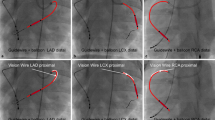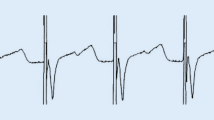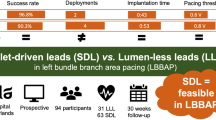Abstract
Background
Transcoronary pacing is used for treatment of unheralded bradycardias in the setting of percutaneous coronary interventions (PCI).
Objectives
In the present study we introduced a new concept – the double guidewire approach – for transcoronary pacing in a porcine model.
Methods
Transcoronary pacing was applied in 16 adult pigs under general anaesthesia in an animal catheterization laboratory. A special guidewire with electrical insulation by PTFE coating except for the distal part of the guidewire was positioned in the periphery of a coronary artery serving as the cathode. As the indifferent anode, an additional standard floppy tip guidewire was advanced into the proximal part of the same coronary vessel. The efficacy of double guidewire transcoronary pacing was assessed by measurement of threshold and impedance data and the magnitude of the epicardial electrogram compared with unipolar transcoronary pacing using a standard cutaneous patch electrode as indifferent anode.
Results
Transcoronary pacing was effective in all cases. Pacing thresholds obtained with the double guidewire technique (1.5 ± 0.9 V) were similar to those obtained by standard unipolar transcoronary pacing with a cutaneous patch electrode (1.2 ± 0.7 V) and unipolar transvenous pacing against the same cutaneous patch electrode (1.5 ± 1.0 V). Bipolar transvenous pacing yielded the lowest pacing threshold at 0.8 ± 0.4 V.
Conclusions
Transcoronary pacing in the animal model with the novel “double guidewire approach” is a simple and effective pacing technique with comparable pacing thresholds obtained by standard unipolar transcoronary and transvenous pacing.
Zusammenfassung
Hintergrund
Die transkoronare Notfallstimulation ist ein Verfahren zur Therapie unerwarteter Bradykardien bei perkutanen Koronarinterventionen (PCI).
Ziel der Arbeit
In der vorliegenden Studie wurde hierzu ein neues Konzept – die „Doppeldrahtstimulation“ unter Verwendung eines beschichteten Führungsdrahts – im Tierexperiment am Schwein evaluiert.
Methoden
Die transkoronare Stimulation wurde in Allgemeinanästhesie bei 16 erwachsenen Schweinen in einem Tierkatheterlabor durchgeführt. Hierzu wurde ein spezieller Führungsdraht – mit elektrischer Isolierung durch PTFE-Beschichtung außer im distalen Teil des Führungsdrahts – in der Peripherie des entsprechenden Gefäßes positioniert. Er diente als Kathode. Ein zweiter Standardführungsdraht mit biegsamer Spitze wurde in den proximalen Anteil desselben Koronargefäßes vorgeschoben und diente als indifferente Elektrode. Die Wirksamkeit der transkoronaren Stimulation mit doppeltem Führungsdraht wurde anhand der Messung der Reizschwellen- und Impedanzdaten sowie der Amplitude des epikardialen Elektrogramms im Vergleich zur unipolaren transkoronaren Stimulation unter Einsatz einer Standard-Hautklebeelektrode als indifferente Anode ermittelt.
Ergebnisse
Mit der Technik der transkoronaren „Doppeldrahtstimulation“ konnte eine 100 %ige Stimulationseffizienz bei einer Reizschwelle von 1,5 ± 0,9 V erzielt werden. Dabei war die Reizschwelle ähnlich wie bei unipolarer transkoronarer Standardstimulation mit einer Hautklebeelektrode (1,2 ± 0,7 V) und unipolarer transvenöser Stimulation gegen dieselbe Hautklebeelektrode (1,5 ± 1,0 V). Die bipolare transvenöse Stimulation führte zur niedrigsten Reizschwelle von 0,8 ± 0,4 V.
Schlussfolgerung
Das vorgestellte neuartige „Doppeldrahtkonzept“ ist im Tiermodell somit ein effektives und in der Anwendung einfaches Konzept für eine transkoronare Notfallstimulation bei Koronarinterventionen, dabei sind die Reizschwellen mit unipolarer transkoronarer Standardstimulation und transvenöser Stimulation vergleichbar.



Similar content being viewed by others
References
Meier B, Rutishauser W (1985) Coronary pacing during percutaneous transluminal coronary angioplasty. Circulation 71:557–561
Meier B (2004) Left ventricular pacing for bradycardia in the cardiac catheterization laboratory. Catheter Cardiovasc Interv 62(1):31
Heinroth KM, Stabenow I, Moldenhauer I et al (2006) Temporary trans-coronary pacing by coated guidewires: a safe and reliable method during percutaneous coronary intervention. Clin Res Cardiol 95(4):206–211
Murphy JJ (1996) Current practice and complications of temporary transvenous cardiac pacing. Brit Med J 312:1134
Asano M, Mishima A, Ishii T, Takeuchi Y, Suzuki Y, Manabe T (1996) Surgical treatment for right ventricular perforation caused by transvenous pacing electrodes: a report of three cases. Surg Today 26:933–935
Dorros G, Crowley MJ, Simpson AJ et al (1983) Percutaneous transluminal coronary angioplasty: report of complications from the National Heart, Lung, and Blood Institute PTCA Registry. Circulation 67:723
Gilchrist IC, Cameron A (1987) Temporary pacemaker use during coronary arteriography. Am J Cardiol 60(13):1051–1054
Killeavy ES, Ferguson JJI (1990) The use of temporary transvenous pacing catheters during percutaneous transluminal coronary angioplasty. Tex Heart Inst J 17:37–41
Jowett NI, Thompson DR, Pohl JE (1989) Temporary transvenous cardiac pacing: 6 years experience in one coronary care unit. Postgrad Med J 65(762):211–215
Zeymer U, Zahn R, Hochadel T et al (2004) Indications and complications of invasive diagnostic procedures and percutaneous coronary interventions in the year 2003: Results of quality control registry of the Arbeitsgemeinschaft Leitende Kardiologische Krankenhausärzte (ALKK). Z Kardiol 93:392–398
Jobs A, Thiele H (2015) ESC guidelines 2015 : Non-ST-elevation acute coronary syndrome. Herz 40(8):1027–1033
Levine GN, O’Gara PT, Bates ER et al (2016) ACC/AHA/SCAI Focused Update on Primary Percutaneous Coronary Intervention for Patients With ST-Elevation Myocardial Infarction: An Update of the 2011 ACCF/AHA/SCAI Guideline for Percutaneous Coronary Intervention and the 2013 ACCF/AHA Guideline for the Management of ST-Elevation Myocardial Infarction: A Report of the American College of Cardiology/American Heart Association Task Force on Clinical Practice Guidelines and the Society for Cardiovascular Angiography and Interventions. J Am Coll Cardiol 67(10):1235–1250
Gilchrist IC (2010) Radial approach to right heart catheterization and intervention. Indian Heart J 62(3):245–250
Heinroth KM, Carter JM, Buerke M, Mahnkopf D, Werdan K, Prondzinsky R (2009) Optimizing of transcoronary pacing in a porcine model. J Invasive Cardiol 21(12):634–638
Prondzinsky R, Unverzagt S, Carter JM et al (2012) A novel approach for transcoronary pacing in a porcine model. J Invasive Cardiol 24(9):451–455
Heinroth KM, Unverzagt S, Carter JM et al (2011) Transcoronary pacing in a porcine model – impact of guidewire insulation. J Invasive Cardiol 1(23):108–114
Chatelain P, Meier B, Belenger J, Killisch JP, Cox JL, Rutishauser W (1985) Emergency cardiac pacing via coronary vessel during percutaneous coronary angioplasty. Arch Mal Coeur Vaiss 78:1583–1587
Ohm OJ, Mitamura H, Michelson EL, Sauermelch C, Dreifus LS (1987) Ventricular tachyarrhythmia initiation in a canine model of recent myocardial infarction. Comparison of unipolar cathodal, anodal and bipolar stimulation. Cardiology 74(3):169–181
Cricri P, Trachsel LD, Muller P, Wackerlin A, Reinhart WH, Bonetti PO (2012) Incidence and time frame of life-threatening arrhythmias in patients with ST-segment elevation myocardial infarction undergoing primary percutaneous coronary intervention. Swiss Med Wkly 142:w13604
Kwok CS, Rashid M, Fraser D, Nolan J, Mamas M (2015) Intra-arterial vasodilators to prevent radial artery spasm: a systematic review and pooled analysis of clinical studies. Cardiovasc Revasc Med 16(8):484–490
Movahed MR, Butman SM (2008) The pathogenesis and treatment of no-reflow occurring during percutaneous coronary intervention. Cardiovasc Revasc Med 9(1):56–61
Aung NK, Li L, Su Q, Wu T (2013) Adenosine and verapamil for no-reflow during primary percutaneous coronary intervention in people with acute myocardial infarction. Cochrane Database Syst Rev 6:CD009503
de Cock CC, Res JC, Hendriks ML, Allaart CP (2009) Usefulness of a pacing guidewire to facilitate left ventricular lead implantation in cardiac resynchronization therapy. Pacing Clin Electrophysiol 32(4):446–449
Author information
Authors and Affiliations
Corresponding author
Ethics declarations
Conflict of interest
K.M. Heinroth, S. Unverzagt, D. Mahnkopf, S. Frantz and R. Prondzinsky declare that they have no competing interests.
This study was supported by a restricted grant from Biotronik Cooperation (Biotronik, Berlin, Germany). K.M. Heinroth, S. Unverzagt, D. Mahnkopf, S. Frantz and R. Prondzinsky do not have any affiliations with this company. Data analysis and interpretation was performed completely independent from this company. The study was conducted according to the regulations of the local animal-based research authorities.
Additional information
Redaktion
M. Buerke, Siegen
Rights and permissions
About this article
Cite this article
Heinroth, K.M., Unverzagt, S., Mahnkopf, D. et al. The double guidewire approach for transcoronary pacing in a porcine model. Med Klin Intensivmed Notfmed 112, 622–628 (2017). https://doi.org/10.1007/s00063-016-0235-z
Received:
Accepted:
Published:
Issue Date:
DOI: https://doi.org/10.1007/s00063-016-0235-z




